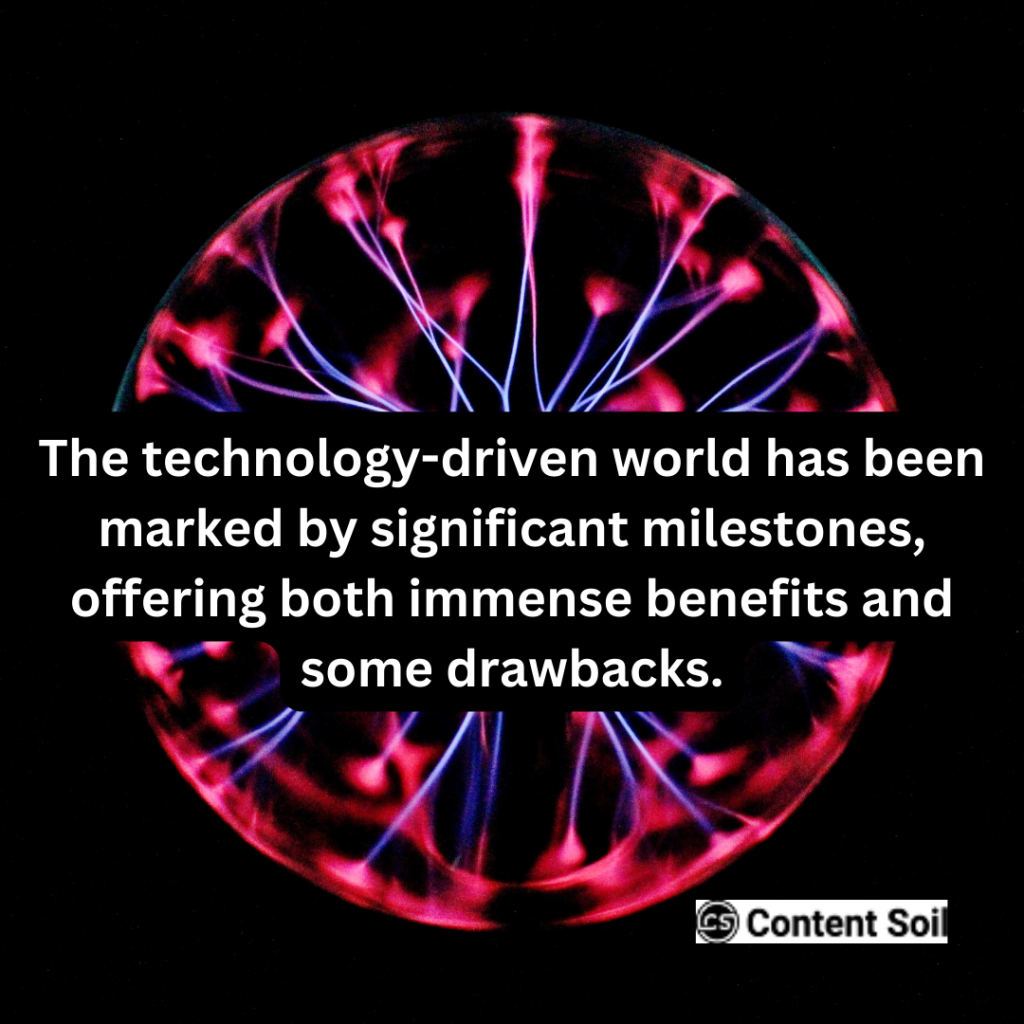Introduction:
Technology, the transformative force that has woven itself into the very fabric of human existence, represents the pinnacle of our intellectual prowess. From the ancient discovery of fire to the present era of artificial intelligence, each innovation marks a chapter in the ongoing saga of human ingenuity. The introduction of technology to mankind has been nothing short of revolutionary, altering the course of history and reshaping the way we perceive and interact with the world.
In its infancy, technology manifested as rudimentary tools, amplifying our ability to manipulate the environment. As time unfurled its tapestry, the loom of innovation wove intricate patterns—wheels, written language, and printing presses—that bound societies together and accelerated the dissemination of knowledge. The Industrial Revolution heralded an age of mechanization, propelling humanity into an era of mass production and economic metamorphosis.
The 20th century witnessed the advent of electronics and computing, ushering in the Information Age. Microchips became the neurons of a global brain, connecting individuals across continents in the blink of an eye. The internet, a virtual agora, emerged as a platform for instantaneous communication and the exchange of ideas.
Today, as we stand on the precipice of the Fourth Industrial Revolution, technology is transcending its role as a mere tool; it is becoming a co-creator of our reality. Artificial intelligence, biotechnology, and nanotechnology are converging to redefine the very essence of what it means to be human. The introduction of technology to mankind has been a perpetual dance of innovation and adaptation—a dance that shows no signs of slowing as we continue to choreograph our destiny with the ever-evolving rhythms of progress.
The technological landscape has undergone a revolutionary transformation from the 1960s to the present day, with innovations shaping every aspect of human life. This journey has been marked by significant milestones, offering both immense benefits and some drawbacks.
1960s: The Dawn of Computing
The 1960s witnessed the emergence of mainframe computers, marking the beginning of the digital era. IBM introduced the System/360, a family of mainframes that could be easily upgraded. While these machines were massive and expensive, they laid the groundwork for future developments.
Benefits:
- Improved efficiency in data processing and calculations.
- Facilitated scientific research and complex simulations.
- Paved the way for the development of programming languages like Fortran and COBOL.
Drawbacks:
- Limited accessibility due to high costs and size.
- Lack of user-friendly interfaces.
1970s: Rise of Personal Computing
The 1970s saw the advent of microprocessors and the birth of personal computing. The Altair 8800, the first personal computer kit, was introduced in 1975, setting the stage for the PC revolution.
Benefits:
- Increased accessibility with personal computers.
- Emergence of software development industry.
- Home computing started to gain popularity.
Drawbacks:
- Limited processing power and storage capacity.
- Lack of standardization in software.
1980s: The PC Boom and Connectivity
The 1980s witnessed the proliferation of personal computers, with IBM’s introduction of the PC in 1981. The development of local area networks (LANs) also began, laying the foundation for increased connectivity.
Benefits:
- Rapid growth of software industry.
- Improved user interfaces and graphic capabilities.
- Networking technologies started connecting computers.
Drawbacks:
- Limited interconnectivity between different systems.
- Security concerns with the rise of computer viruses.
1990s: The Internet Revolution
The 1990s marked the widespread adoption of the internet, revolutionizing communication and information access. The World Wide Web became publicly accessible, and e-commerce began to take off.
Benefits:
- Global connectivity and instant communication.
- E-commerce and online services.
- Emergence of search engines like Google.
Drawbacks:
- Privacy concerns with the growing digital footprint.
- Rise of cybercrime and hacking activities.
2000s: Mobile and Social Media Era
It was the 2000s that saw the rise of mobile technology with the introduction of smartphones and the popularization of social media platforms. The iPhone, launched in 2007, redefined mobile computing.
Benefits:
- Mobile computing and on-the-go accessibility.
- Social connectivity and information sharing.
- App ecosystems and mobile-based services.
Drawbacks:
- Increased screen time and potential for addiction.
- Privacy issues with extensive data collection by tech companies.
2010s: Cloud Computing and Artificial Intelligence
Cloud computing became a dominant force in the 2010s, enabling remote storage and access to data. Artificial Intelligence (AI) and machine learning gained prominence, impacting various industries.
Benefits:
- Scalable and flexible computing resources.
- Advancements in AI, automation, and data analytics.
- Internet of Things (IoT) connectivity.
Drawbacks:
- Concerns about job displacement due to automation.
- Ethical concerns regarding AI decision-making.
2020s: Continued Advancements and Challenges
As of my last update in September 2021, the 2020s were expected to bring further advancements in technologies like 5G, quantum computing, and augmented reality. However, challenges such as digital inequality, cybersecurity threats, and ethical concerns regarding emerging technologies persist.
Benefits:
- Continued technological advancements for improved efficiency.
- Potential breakthroughs in healthcare, energy, and sustainability.
- Enhanced connectivity with 5G and improved computing capabilities.
Drawbacks:
- Ongoing concerns about data privacy and security.
- Ethical dilemmas related to advanced technologies like AI.
- Challenges associated with managing and mitigating the environmental impact of technology.
Conclusion:
The evolution of technology from the 1960s to the 2020s has been a transformative journey, bringing unprecedented benefits and posing challenges that require careful consideration. As technology continues to advance, it is crucial for society to navigate these changes responsibly, ensuring that the benefits are maximized while addressing the drawbacks and potential risks.


